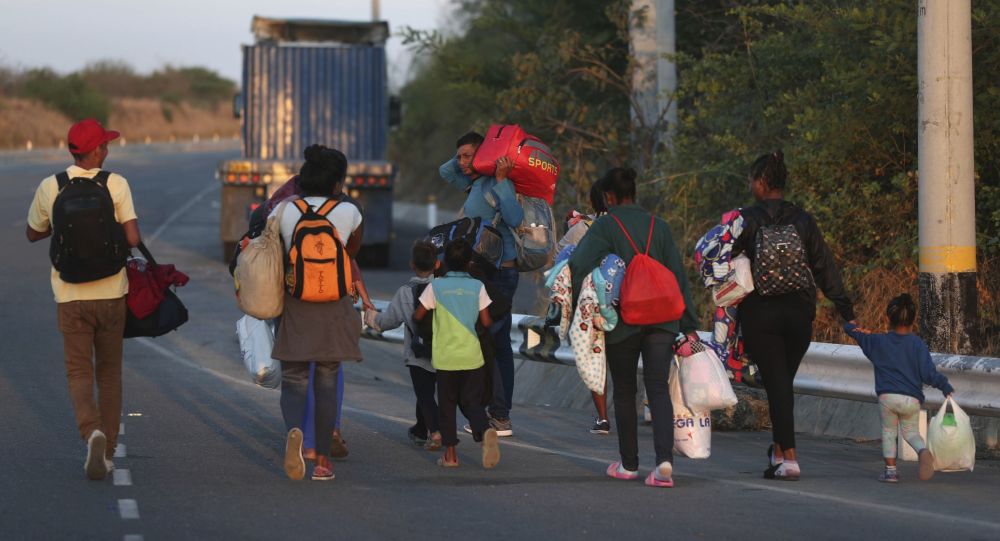RIO DE JANEIRO, BRAZIL – A mixture of chance, discretion, and arbitrariness of the policeman on duty defines the immediate destiny of hundreds of Venezuelan migrants who, every day, try to cross the border from Ecuador to Peru through a chaotic bridge, where the Venezuelan crisis is still very present, and the human traffic towards the south does not cease.
Tension is in the air. Hundreds, sometimes thousands, of people cross this point every day. Most of them are Venezuelans who have either just entered Peru or are making their last stop before leaving the Andean country for a destination unknown to many.
Not far away, some thirty migrants are resting and sheltering under wooden roofs from the harsh sun. One of them plays children’s songs on a loudspeaker that he sings with his two young children while the three older ones soak in a dirty canal a few steps from the bus terminal.

Just a few hours ago, they crossed the bridge that connects the Peruvian Aguas Verdes with the Ecuadorian city of Huaquillas, which, since mid-February and after almost two years, closed due to the pandemic, allowing the entry of citizens of the two bordering countries.
It does not allow Venezuelans to enter, but this family was lucky. The police did not stop them even though they carried three large bags, a baby carriage, and two dogs – the gear they had traveled with for three years when they left Venezuela.
“We stayed for a while in Cali, some time in Bogota, in Medellin, until we decided to come to Ecuador. We stayed there for about fifteen days, and we came to Peru because we are looking to earn money faster by working,” Gladys Hurtado, the family’s mother, said.
Their idea was to get to Lima, the city with the largest community of Venezuelans outside their country, but during the trip, the children got sick, and her husband fell off the trailer of a cargo truck, “he broke his leg, and now he needs an operation”.
So, at least for a few days, they will stay in the streets of the city of Tumbes, the largest in the area, “selling covers, candies, and lollipops”.
“Let’s see what awaits us here, and, if not, we will have to go back,” he confesses.
A PERSISTENT FLOW
In Peru – which, after Colombia, is the second country that has received the most Venezuelans (1.3 million) – “Venezuelan migration collapsed in 2019″, points out the regional manager of Social Development of Tumbes, Luis Alfonzo Cerna.
That year, only through the Binational Border Attention Center (Cebaf), an average of 3,000 citizens from the oil-producing country entered daily. Today, according to the regional government, between 55 and 75 people enter legally.
But these numbers are far from reality because to pass through this border control point, migrants need a passport, a humanitarian visa, and a complete vaccination schedule against COVID-19, requirements that practically no one fulfills.
For this reason, the bridge that connects Aguas Verdes with Huaquillas and the clandestine passages around it are by far the most common strategies to irregularly enter or leave the Andean country.
Thus, it is impossible to precisely know how many people continue to cross the border, a flow that is undoubtedly less than three years ago but does not cease.
International agencies make estimated counts on the ground, but their figures differ. They estimate that between 300 and 1,600 people cross the border every day, between legal and illegal.
However, they agree that of all the displaced people who cross the border every day, approximately 60% enter Peru, while the remaining 40% leave in the direction of Ecuador.
THOSE WHO RETURN BUT NOT HOME
The latter is the case of Jonathan Hurtado. He rests under a shady porch of the Plaza de Armas in Huaquillas with his wife and two children, ten and eight years old, surrounded by backpacks, suitcases, blankets, and stuffed animals.
The four of them have been sleeping here for days, where, according to him, they arrived “through trails” and at the mercy of the coyotes who maintain the “dirty business” of illegal passes.
They are walking from Lima, a distance of 1,290 kilometers, and do not know where they are headed. For now, returning to Venezuela is not an option, so they are debating whether to try Ecuador or Colombia.
Jonathan already spent several months in both countries with his family, who left his native country in 2017 due to “a political problem”. He says he was a chauffeur for a minister until he was “unjustifiably” fired.
Returning to Venezuela is also not on Gladys’ radar because, despite recognizing that she is dying to go back, the woman asserts that first, she needs to “find a job where I can collect some cash”. At the same time, she prays and hopes that her distant dream will come true: that her country “stabilizes”.
With information from EFE

